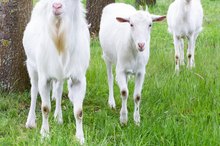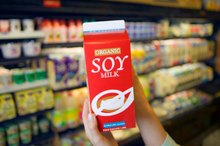What does fact checked mean?
At Healthfully, we strive to deliver objective content that is accurate and up-to-date. Our team periodically reviews articles in order to ensure content quality. The sources cited below consist of evidence from peer-reviewed journals, prominent medical organizations, academic associations, and government data.
- “Journal of Dairy Science”; Composition of Milk From Llamas in the United States; D.E. Morin et. al.; August 1995
- “Journal of Dairy Science”; Composition of Milk From Llamas in the United States; D.E. Morin et. al.; August 1995
The information contained on this site is for informational purposes only, and should not be used as a substitute for the advice of a professional health care provider. Please check with the appropriate physician regarding health questions and concerns. Although we strive to deliver accurate and up-to-date information, no guarantee to that effect is made.
Llama Milk & Lactose
The llama, an animal classified in the camelid family with camels and alpacas, lives in the Andean Mountain region of South America. As a domesticated animal, llamas can work like a horse or mule pulling a cart or carrying packs, while leaving a smaller environmental footprint, meaning they do less damage to the fields or trails. Llamas can guard sheep, produce high quality wool and graze in pastures, making them useful and easy to maintain as a livestock animal. Because they are mammals, female llamas produce milk to feed their young. Their milk contains lactose.
What is Lactose?
Sugar molecules consist of carbon, hydrogen and oxygen atoms hooked together to form a ring. Sugar exists in a variety of chemical forms including sucrose or table sugar; fructose, which is found in fruit; and lactose, the sugar in milk. Lactose consists of two smaller sugar molecules known as glucose and galactose bound together. Lactose does not taste as sweet as table sugar, but does give milk and other dairy products their slightly sweet flavor. Milk produced by all mammals, including llamas, contains lactose.
- Sugar molecules consist of carbon, hydrogen and oxygen atoms hooked together to form a ring.
- Milk produced by all mammals, including llamas, contains lactose.
Llama Milk Composition
Lactose and Sheep Milk
Learn More
Like all mammals, llamas produce milk to feed their babies, known as crias. Llama milk contains more protein than cow’s milk and goat’s milk, with 4.23 percent protein compared to 3.3 percent in cow’s milk and 2.9 percent in goat’s milk, according to the Alpaca Breeders of Southern California. Llama milk also contains more calcium with 1,701 ppm as compared to 1,080 ppm in cow’s milk and 1,400 in goat’s milk. In addition llama milk contains higher amounts of phosphorus and potassium. Despite the nutritional advantages llama milk offers, it likely will not replace cow’s milk or goat’s milk as a major source of milk due to the small population of llamas and their low milk production.
- Like all mammals, llamas produce milk to feed their babies, known as crias.
- Llama milk contains more protein than cow’s milk and goat’s milk, with 4.23 percent protein compared to 3.3 percent in cow’s milk and 2.9 percent in goat’s milk, according to the Alpaca Breeders of Southern California.
Llama Milk Lactose
Only 80,000 to 100,000 llamas live in the United States, a small population when compared to other livestock used for milk production, according to the Llama Lifestyle Marketing Association 2. In addition, each female llama only produces about 60 mL of milk at a time, which means their young must suckle often to get adequate nutrition. Although you can drink llama milk, many people looking for a substitute for cow’s milk need a milk product that does not contain lactose due to lactose intolerance. Llama’s milk contains a higher lactose content than cow’s milk with 5.93 percent lactose compared to 4.7 percent.
- Only 80,000 to 100,000 llamas live in the United States, a small population when compared to other livestock used for milk production, according to the Llama Lifestyle Marketing Association 2.
- In addition, each female llama only produces about 60 mL of milk at a time, which means their young must suckle often to get adequate nutrition.
Lactose Intolerance
How Much Semen Is a Body Able to Make?
Learn More
When you consume milk and dairy products your body must break down the lactose to absorb the sugar and convert it to usable energy. The enzyme called lactase, produced by the cells lining the small intestine, breaks the bond between the glucose and galactose molecules. The small intestine can then absorb the smaller sugar molecules. Babies produce large amounts of lactase to digest the lactose in their milk. As you age, your body slows down the production of lactase. Without enough lactase, you cannot absorb the lactose and it stays in the digestive tract. The large intestine tries to break down the lactose through a process of fermentation carried out by bacteria. This causes the symptoms associated with lactose intolerance, which include chronic diarrhea, gas, bloating and stomach pains.
- When you consume milk and dairy products your body must break down the lactose to absorb the sugar and convert it to usable energy.
- The enzyme called lactase, produced by the cells lining the small intestine, breaks the bond between the glucose and galactose molecules.
Related Articles
References
- University of Illinois College of Veterinary Medicine: Llamas a Different Kind of Pet; Linda March; October 1995
- “Journal of Dairy Science”; Composition of Milk From Llamas in the United States; D.E. Morin et. al.; August 1995
- Boyce JA et al. Guidelines for the Diagnosis and Management of Food Allergy in the United States: Report from the NIAID-sponsored Expert Panel. J Allergy Clin Immunology. 2010.
- Food Allergy Research and Education (FARE) http://www.foodallergy.org/allergens/milk-allergy
Writer Bio
Stephanie Chandler is a freelance writer whose master's degree in biomedical science and over 15 years experience in the scientific and pharmaceutical professions provide her with the knowledge to contribute to health topics. Chandler has been writing for corporations and small businesses since 1991. In addition to writing scientific papers and procedures, her articles are published on Overstock.com and other websites.







